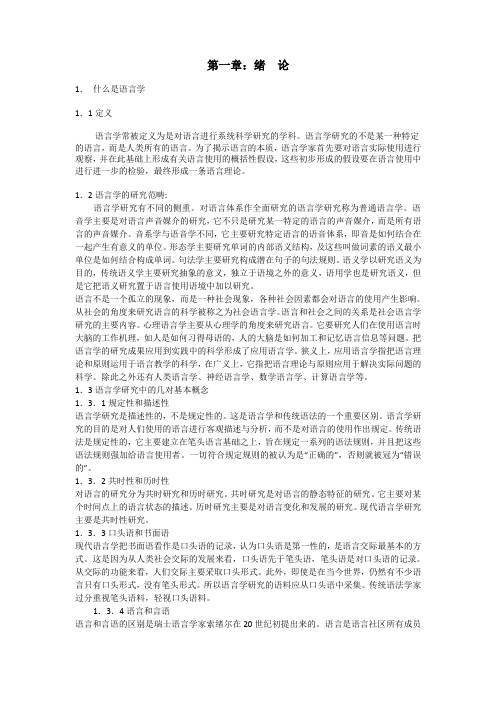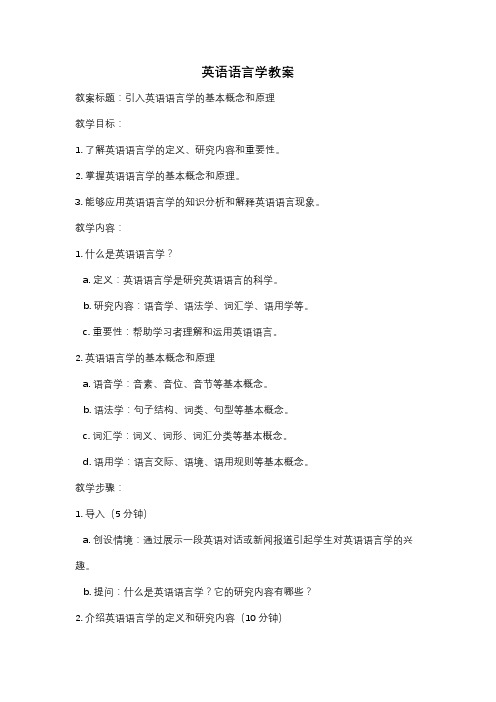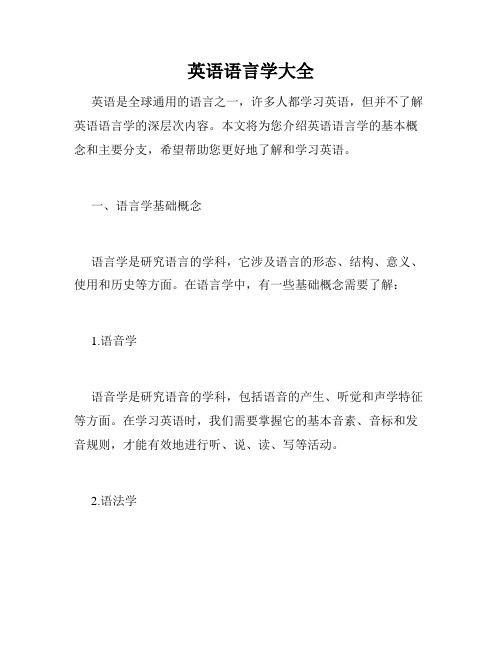英语语言学
英语语言学第一章、第二章

第一章:绪论1.什么是语言学1.1定义语言学常被定义为是对语言进行系统科学研究的学科。
语言学研究的不是某一种特定的语言,而是人类所有的语言。
为了揭示语言的本质,语言学家首先要对语言实际使用进行观察,并在此基础上形成有关语言使用的概括性假设,这些初步形成的假设要在语言使用中进行进一步的检验,最终形成一条语言理论。
1.2语言学的研究范畴:语言学研究有不同的侧重。
对语言体系作全面研究的语言学研究称为普通语言学。
语音学主要是对语言声音媒介的研究,它不只是研究某一特定的语言的声音媒介,而是所有语言的声音媒介。
音系学与语音学不同,它主要研究特定语言的语音体系,即音是如何结合在一起产生有意义的单位。
形态学主要研究单词的内部语义结构,及这些叫做词素的语义最小单位是如何结合构成单词。
句法学主要研究构成潜在句子的句法规则。
语义学以研究语义为目的,传统语义学主要研究抽象的意义,独立于语境之外的意义,语用学也是研究语义,但是它把语义研究置于语言使用语境中加以研究。
语言不是一个孤立的现象,而是一种社会现象,各种社会因素都会对语言的使用产生影响。
从社会的角度来研究语言的科学被称之为社会语言学。
语言和社会之间的关系是社会语言学研究的主要内容。
心理语言学主要从心理学的角度来研究语言。
它要研究人们在使用语言时大脑的工作机理,如人是如何习得母语的,人的大脑是如何加工和记忆语言信息等问题。
把语言学的研究成果应用到实践中的科学形成了应用语言学。
狭义上,应用语言学指把语言理论和原则运用于语言教学的科学,在广义上,它指把语言理论与原则应用于解决实际问题的科学。
除此之外还有人类语言学、神经语言学、数学语言学、计算语言学等。
1.3语言学研究中的几对基本概念1.3.1规定性和描述性语言学研究是描述性的,不是规定性的。
这是语言学和传统语法的一个重要区别。
语言学研究的目的是对人们使用的语言进行客观描述与分析,而不是对语言的使用作出规定。
传统语法是规定性的,它主要建立在笔头语言基础之上,旨在规定一系列的语法规则,并且把这些语法规则强加给语言使用者。
英语语言学知识点总结

英语语言学知识点总结
英语语言学是研究英语语言及其发展历史、语音、语法、词汇、语用等方面的学科。
以下是一些英语语言学的知识点总结:
1. 英语语音学:英语语音学主要研究英语的发音、声调、重音等语音现象。
其中,英语的发音规则主要包括元音、辅音和声调等方面的规则。
2. 英语语法学:英语语法学主要研究英语的语法结构和规则,包括句子结构、时态、语态、名词、形容词、副词等语法范畴。
3. 英语词汇学:英语词汇学主要研究英语的词汇构成、演化和使用情况,包括单词、词组和习语等方面的研究。
4. 英语语用学:英语语用学主要研究英语的语用功能和语境,包括语言交际、暗示、礼貌、语用失误等方面的研究。
5. 英语语音语调学:英语语音语调学主要研究英语的语音语调系统,包括英语的发音、声调、重音、节奏等方面的研究。
6. 英语文体学:英语文体学主要研究英语的文体风格和语言习惯,包括正式文体、口语文体、文学文体等方面的研究。
7. 英语词汇记忆学:英语词汇记忆学主要研究如何有效地记忆英语词汇,包括词汇记忆的方法、技巧和策略等方面的研究。
8. 英语跨文化交际学:英语跨文化交际学主要研究英语在不同文化中的交际和使用,包括跨文化沟通、文化差异、交际礼仪等方面的研究。
以上是一些英语语言学的重要知识点总结,不同学科之间的交叉
和融合也在不断推进着英语语言学的发展。
英语语言学知识点

英语语言学知识点英语语言学是英语语言文学专业培养计划中的一门基础必修课,接下来店铺为你整理了英语语言学知识点,一起来看看吧。
英语语言学知识点:定义1.语言学LinguisticsLinguistics is generally defined as the scientific study of language.2.普通语言学General LinguisticsThe study of language as a whole is often called General linguistics.3.语言languageLanguage is a system of arbitrary vocal symbols used for human communication.语言是人类用来交际的任意性的有声符号体系。
4.识别特征Design FeaturesIt refers to the defining poperties of human language that distinguish it from any animal system of communication.语言识别特征是指人类语言区别与其他任何动物的交际体系的限定性特征。
Arbitrariness任意性Productivity多产性Duality双重性Displacement移位性Cultural transmission文化传递⑴arbitrarinessThere is no logical connection between meanings and sounds.P.S the arbitrary nature of language is a sign of sophistication and it makes it possible for language to have an unlimited sourceof expressions⑵ProductivityAnimals are quite limited in the messages they are able to send.⑶DualityLanguage is a system, which consists of two sets of structures ,or two levels.⑷DisplacementLanguage can be used to refer to contexts removed from the immediate situations of the speaker.⑸Cultural transmissionHuman capacity for language has a genetic basis, but we have to be taught and learned the details of any language system. this showed that language is culturally transmitted. not by instinct. animals are born with the capacity to produce the set of calls peculiar to their species.5.语言能力CompetenceCo mpetence is the ideal user’s knowledge of the rules of his language.6.语言运用performancePerformance is the actual realization of this knowledge in linguistic communication.语言运用是所掌握的规则在语言交际中的体现。
英语语言学教案

英语语言学教案教案标题:引入英语语言学的基本概念和原理教学目标:1. 了解英语语言学的定义、研究内容和重要性。
2. 掌握英语语言学的基本概念和原理。
3. 能够应用英语语言学的知识分析和解释英语语言现象。
教学内容:1. 什么是英语语言学?a. 定义:英语语言学是研究英语语言的科学。
b. 研究内容:语音学、语法学、词汇学、语用学等。
c. 重要性:帮助学习者理解和运用英语语言。
2. 英语语言学的基本概念和原理a. 语音学:音素、音位、音节等基本概念。
b. 语法学:句子结构、词类、句型等基本概念。
c. 词汇学:词义、词形、词汇分类等基本概念。
d. 语用学:语言交际、语境、语用规则等基本概念。
教学步骤:1. 导入(5分钟)a. 创设情境:通过展示一段英语对话或新闻报道引起学生对英语语言学的兴趣。
b. 提问:什么是英语语言学?它的研究内容有哪些?2. 介绍英语语言学的定义和研究内容(10分钟)a. 讲解英语语言学的定义和研究内容,强调其重要性。
b. 提供实例:举例说明语音学、语法学、词汇学和语用学的研究内容。
3. 介绍语音学的基本概念和原理(15分钟)a. 讲解音素、音位和音节的概念和区别。
b. 提供实例:展示不同音素和音位的发音示范。
4. 介绍语法学的基本概念和原理(15分钟)a. 讲解句子结构、词类和句型的概念和分类。
b. 提供实例:分析不同句子结构和词类的句子。
5. 介绍词汇学的基本概念和原理(15分钟)a. 讲解词义、词形和词汇分类的概念和应用。
b. 提供实例:解释不同词义和词形的词汇。
6. 介绍语用学的基本概念和原理(15分钟)a. 讲解语言交际、语境和语用规则的概念和重要性。
b. 提供实例:分析不同语境下的语用规则。
7. 总结与拓展(5分钟)a. 概括英语语言学的基本概念和原理。
b. 提出拓展问题:学生可以通过进一步研究和实践探索英语语言学的更多内容。
教学资源:1. PowerPoint演示文稿,包含英语语言学的定义、研究内容和基本概念。
英语语言学

4)Displacement:We can use language to describe things that are not present, such as something in the past, the future, or things that does not even exist in reality, such as E.T.移位性,指我们用语言可以表达许多不在场的东西,比如外星人
3)Morphology (形态学): the study of the minimal units of meaning—morphemes and word-formation processes, that is , the internal organization of words (研究意义的最小单位—语素合成词过程,即单词的内部构造);
英语语言学
一、语言的特点和功能(Features and Functions of Language)
语言:Language is a system of arbitrary vocal symbols used for human communication
1. Features of Language(言的特点)
3) Contrastivedistribution(对立分布): the typical to be found in Minima Pairs (最小语音对). A Minimal Pair refers to two words which differ from each other by only one distinctive sound (one Phoneme) and which also differ in meaning, for example, bear and pear.如pin和pen
英语语言学分支

英语语言学分支(原创实用版)目录1.英语语言学的分支概述2.语音学3.语法学4.语义学5.语用学6.语言学与其他学科的联系正文一、英语语言学的分支概述英语语言学作为语言学的一个重要分支,主要研究英语的语音、语法、语义、语用等方面的规律。
英语语言学可以分为多个子领域,每个子领域都有其独特的研究方法和目标。
本文将对英语语言学的主要分支进行简要介绍。
二、语音学语音学是研究语音现象的学科,主要关注发音、声调、音位等方面的问题。
在英语语音学中,研究者需要分析英语音标的发音规律,以及不同口音和方言的特点。
此外,语音学还涉及到语音识别和合成等领域。
三、语法学语法学是研究语言结构的学科,主要关注词汇、句子和篇章的组织规律。
在英语语法学中,研究者需要分析英语单词的词性、词序、句子成分等方面的问题。
语法学的研究成果对语言教学、翻译和自然语言处理等方面具有重要意义。
四、语义学语义学是研究语言意义的学科,主要关注词汇、句子和篇章的含义。
在英语语义学中,研究者需要分析英语单词和句子的意义、语义关系等方面的问题。
语义学的研究成果有助于提高语言表达的准确性和理解能力。
五、语用学语用学是研究语言使用情况的学科,主要关注语言在不同情境下的功能和效果。
在英语语用学中,研究者需要分析英语在不同语境、交际目的和文化背景中的使用规律。
语用学的研究成果对跨文化交际、语言教学和翻译等方面具有重要意义。
六、语言学与其他学科的联系英语语言学与许多其他学科有着密切的联系,如心理学、社会学、哲学、计算机科学等。
这些学科的研究成果为英语语言学的研究提供了丰富的理论资源和方法论支持。
同时,英语语言学的研究成果也在这些学科领域产生了广泛的应用价值。
总之,英语语言学作为一个多元化的学科体系,其各个分支领域都有独特的研究内容和方法。
英语语言学大全

英语语言学大全英语是全球通用的语言之一,许多人都学习英语,但并不了解英语语言学的深层次内容。
本文将为您介绍英语语言学的基本概念和主要分支,希望帮助您更好地了解和学习英语。
一、语言学基础概念语言学是研究语言的学科,它涉及语言的形态、结构、意义、使用和历史等方面。
在语言学中,有一些基础概念需要了解:1.语音学语音学是研究语音的学科,包括语音的产生、听觉和声学特征等方面。
在学习英语时,我们需要掌握它的基本音素、音标和发音规则,才能有效地进行听、说、读、写等活动。
2.语法学语法学是研究语言结构和组织的学科,有时也称为句法学。
它研究语言的词类、句子结构、语法关系等方面。
通过学习英语的语法,我们可以正确使用语言,避免出现语法错误。
3.语义学语义学是研究语言意义的学科,它探究词汇、短语和句子意义的形成和变化。
在英语学习中,我们需要理解单词和短语的意义,以及句子的含义,以便正确理解和表达内容。
4.语用学语用学是研究语言使用的学科,包括口语和书面语言的使用场合、对话方式、说话人的语言目标和对听者的影响等方面。
在英语学习中,我们需要了解不同场合和对象的语言使用规范,以便与人交流时更加得心应手。
二、英语语言学的主要分支除了以上基础概念外,英语语言学还有一些重要的学术分支,能够帮助我们更深入地了解和掌握英语。
1.语音学英语语音学探究的是英语中的音素、音标和发音规则等方面,以及与其他语音系统的比较和差异。
2.语法学英语语法学研究的是英语的句法结构、语法关系和句子意义等方面,以及与其他语言的比较和翻译问题。
3.词汇学英语词汇学是研究英语词汇的学科,包括单词的来源、组成和意义等方面,以及与其他语言的比较和词汇翻译问题。
4.语用学英语语用学研究的是英语在语言使用中的实际应用,包括语言交际、言语行为、语境和语言目的等方面。
5.文本语言学英语文本语言学是研究英语文本的结构、组织和语言特点等方面的学科,包括语篇分析和修辞分析等内容。
英语语言学导论

英语语言学导论在现代社会中,英语已成为世界上最重要的语言之一。
它的使用广泛,并在全球范围内被广泛教授和学习。
英语语言学是研究英语语言的起源、结构、运用和变化的学科。
本文将介绍英语语言学的基本概念和主要研究领域。
第一部分:语言的定义和特征语言是人类特有的沟通工具。
它通过词汇、语法和语音等要素传达思想和意义。
英语作为一种语言具有以下几个特征:1. 音位学:英语的语音系统是非常复杂的,包含了多种元音和辅音的组合。
音位学研究这些语音单元的发音规则和区别。
2. 词汇学:词汇学是研究语言中的词汇和词汇的组合方式。
英语借用了许多其他语言的词汇,并形成了自己独特的词汇体系。
3. 语法学:语法学研究语言的句法规则和结构。
英语有一套复杂的语法规则,包括句子成分的排列、时态和语态等。
4. 语义学:语义学研究语言的意义和符号之间的关系。
英语语义学关注单词和短语的意义以及其在句子中的作用。
第二部分:英语语言学的重要理论1. 生成语法:生成语法是描述语言结构的一种理论框架。
它认为语言的句子是由一系列规则翻译而来的。
在英语语言学中,生成语法的应用被广泛讨论和研究。
2. 语言变化:语言变化研究语言在时间和空间上的变化。
英语是一个活跃的语言,它经历了多次变化和演化。
研究英语变化可以帮助我们理解语言的发展和演变过程。
3. 语用学:语用学关注语言使用的背景和意图。
在英语语言学中,语用学研究口语交流、演讲和修辞等方面。
第三部分:英语作为国际语言的影响英语作为国际语言对全球化和文化交流产生了重要影响。
它被广泛用于商务、科技和学术交流等领域。
英语语言学的研究对英语作为国际语言的发展和应用具有重要意义。
1. 跨文化交际:英语作为国际语言使不同文化之间的交流更加方便。
研究跨文化交际可以帮助人们更好地理解和应对跨文化交流中的障碍和挑战。
2. 语言教育:英语作为国际语言受到广泛学习者的关注和学习。
英语语言学的研究对英语教育的改进和发展具有重要作用。
- 1、下载文档前请自行甄别文档内容的完整性,平台不提供额外的编辑、内容补充、找答案等附加服务。
- 2、"仅部分预览"的文档,不可在线预览部分如存在完整性等问题,可反馈申请退款(可完整预览的文档不适用该条件!)。
- 3、如文档侵犯您的权益,请联系客服反馈,我们会尽快为您处理(人工客服工作时间:9:00-18:30)。
一、语言和语言学1、语言的区别性特征:Design of features of language任意性 arbitrariness 指语言符号和它代表的意义没有天然的联系二重性 duality 指语言由两层结构组成创造性 creativity 指语言可以被创造移位性 displacement 指语言可以代表时间和空间上不可及的物体、时间、观点2、语言的功能(不是很重要)信息功能 informative人际功能 interpersonal施为功能 performative感情功能 emotive function寒暄功能 phatic communication娱乐功能 recreational function元语言功能 metalingual function3、语言学主要分支语音学 phonetics 研究语音的产生、传播、接受过程,考查人类语言中的声音音位学 phonology 研究语音和音节结构、分布和序列形态学 morphology 研究词的内部结构和构词规则句法学 syntax 研究句子结构,词、短语组合的规则语义学 semantics 不仅关心字词作为词汇的意义,还有语言中词之上和之下的意义。
如语素和句子的意义语用学 pragmatics 在语境中研究意义4、宏观语言学 macrolingustics心理语言学 psycholinguistics 社会语言学 sociolinguistics 人类语言学 anthropological linguistics 计算机语言学 computational linguistics5 语言学中的重要区别规定式和描写式:规定式:prescriptive说明事情应该是怎么样的描写式:descriptive 说明事情本来是怎么样的共时研究和历时研究:共时:synchronic 研究某个特定时期语言第 1 页历时:diachronic 研究语言发展规律语言和言语:语言:langue指语言系统的整体言语:parole指具体实际运用的语言语言能力和语言运用:乔姆斯基(chomsky提出)能力:competence用语言的人的语言知识储备运用:performance 真实的语言使用者在实际中的语言使用二、语音学1、语音学分支发音语音学articulatory phonetics研究语言的产生声学语言学acoustic phonetics 研究语音的物理属性听觉语音学 auditory phonetics 研究语言怎样被感知2 IPA(国际音标)是由daniel Jones琼斯提出的三、音位学1、最小对立体minimal pairs2、音位 phoneme3 音位变体 allophones4 互补分布 complementary distribution5 自由变体 free variation6 区别特征 distinctive features7 超音段特征 suprasegmental feature音节 syllable 重音stress 语调tone 声调intonation四 形态学1 词的构成语素morpheme 自由语素free morpheme 粘着语素bound morphemeRoot 词根 词缀affix 词干stem屈折词汇和派生词汇 inflectional affix and derivational affix 2 特有的词汇变化lexical change proper新创词语invention 混拼词blending 缩写词abbreviation第 2 页首字母缩写词 acronym 逆构词汇back-formation例:editor—edit类推构词analogiacal creation 例:work-worked,,slay-slayed外来词 borrowing五 句法学1 范畴category 数number 性gender 格case 时tense 体aspect一致关系concord 支配关系govenrment2 结构主义学派the structure approach组合关系 syntagmatic relation词和词组合在一起聚合关系 paradigmatic 具有共同的语法作用的词聚在一起结构和成分 construction and constituents :句子不仅是线性结构liner structure还是层级结构hierarchical structure (句子或短语被称为结构体,而构成句子或短语即结构体的称为成分)3 直接成分分析法 immediate constitutional analysis指把句子分成直接成分-短语,再把这些短语依次切分,得到下一集直接成分,这样层层切分,直到不能再分4 向心结构和离心结构endocentric and exocentric constructions向心:指一个结构中有中心词,例an old man ,中心为man离心:指结构中没有明显的中心词。
例:on the shelf5 生成学派the generative approach深层结构deep structure指机构关系中的潜在层面underlying level表层结构surface structure指结构形成的最后结果阶段final stage6 功能学派the functional approach主位与述位 theme and rheme主位:谈话中已知的信息,说话者从它谈起known,述位:与说话者内容有关的内容what the speaker states about7 交际力communicative and dynamism简称CD指句子成分对交际发展所作的贡献的程度六、语义学1 利奇的意义七分法Leech and his 7 types of meaning第 3 页概念意义conceptual meaning 字面意义内涵意义connotative meaning 实际交往过程中所指的事物社会意义情感意义 affective meaning反射意义 reflective meaning 由一个词语联想起来的另外一种意义搭配意义 collocative meaning主位意义 thematic meaning 通过调整信息的顺序和强调内容所表达的意义2 指称论 referential theory指将词的意义和他所指的食物联系起来的意义理论3 语义三角semantic triangle 奥格登和理查兹提出Symbol或form 指语言要素(如词和语素),the linguistic elements能指thought指概念concept所指reference 指经验世界中的物体the object in the word of experience涵义sense语言形式的意义4 主要涵义关系○同义关系synonymy地域同义词dialectal synonymy风格同义词 stylistic synonyms感情同义词 synonymys that differ in connotation意义相同,但内涵不同,有褒有贬○反义关系antonymy等级反义关系gradable antonymy 例cool-warm ;hot-cold互补反义关系 complementary antonymy,肯定A就否定B,否定B 就肯定A,例dead-alive 反向反义关系converse antonymy .reversal of a relationship between 2 entities.例 husband-wife; teacher-student○上下义关系hyponymy 意义包含关系。
例:花-水仙、玫瑰、百合补充:同音同形异义关系homonymy一词多义 polysemy七、语用学第 4 页1 言语行为理论speech act theory奥斯汀提出John Langshaw Austin认为人在说话的同时也在进行一定的行为动作○施为句和叙事句performative and constative施为句:实施某种行为。
叙事句:描述说话人在说话时所作的动作。
○行事行为理论a theory of the illocutionary act言内行为:locutionnary act表述字面意思言外行为:illoutionary act 因为言语本身的习惯力量随之产生的其他一些行为言后行为:perlocutionnary act 话语在听者身上产生的效果2 会话含义理论 the theory of conversational implicature格赖斯提出Herbert Paul Grice○合作原则:说话人和听话人为达一定的交际目的,都有一种默契,一种都遵循的原则○ 四个准则four categories of maxims数量、质量、关系、方式(manner)准则3 后格赖斯时期的发展○关联理论:relevance theory:交际应被看做一种表明自身说话意图的行为every act of ostensive(直接表明的) communication communicates the presumption of its own optimal relevance○数量关系和关系原则the Q-and R-principles由霍恩Laurence Horn 提出八 现代语言学理论和流派1 索绪尔Saussure瑞士语言学家,“现代语言学之父”或者“使语言学科走向现代的大师”2 布拉格学派Prague School贡献:共时语言学研究,从“功能”角度看待语言,强调语言的系统性,把语言看做一种功能突出贡献:语音学说,及其划分语音学和音位学突出:Trubetzkoy特鲁别茨柯依:提出语音学属于言语,音位学属于语言,提出音位概念4 伦敦学派 the Lundon School:系统语言学和功能语言学创始人:弗斯Firth.人物:弗斯受马林诺夫斯基影响。
韩礼德为新弗斯派领袖三人都强调语第 5 页言环境和语言系统的重要性韩礼德和系统功能语法:由系统语法和功能语法构成。
把实际使用的语言现象作为研究对象5 美国结构主义American Structuralism共时语言学分支,由博厄斯提出F.Bos.○撒皮尔-沃尔夫假说Sapir-Whorf Hypothesis语言相对论-语言决定论○布隆菲尔德Bloomfield《语言论》-20世纪被大西洋两岸同时奉为科学的方法论典范和语言学领域的杰出代表。
描述语言学的代表人物6 转换生成语法transformational–generative grammar乔姆斯基提出Chomsky.认为语言是某种天赋,语言习得机制Language Acquisition device第 6 页。
